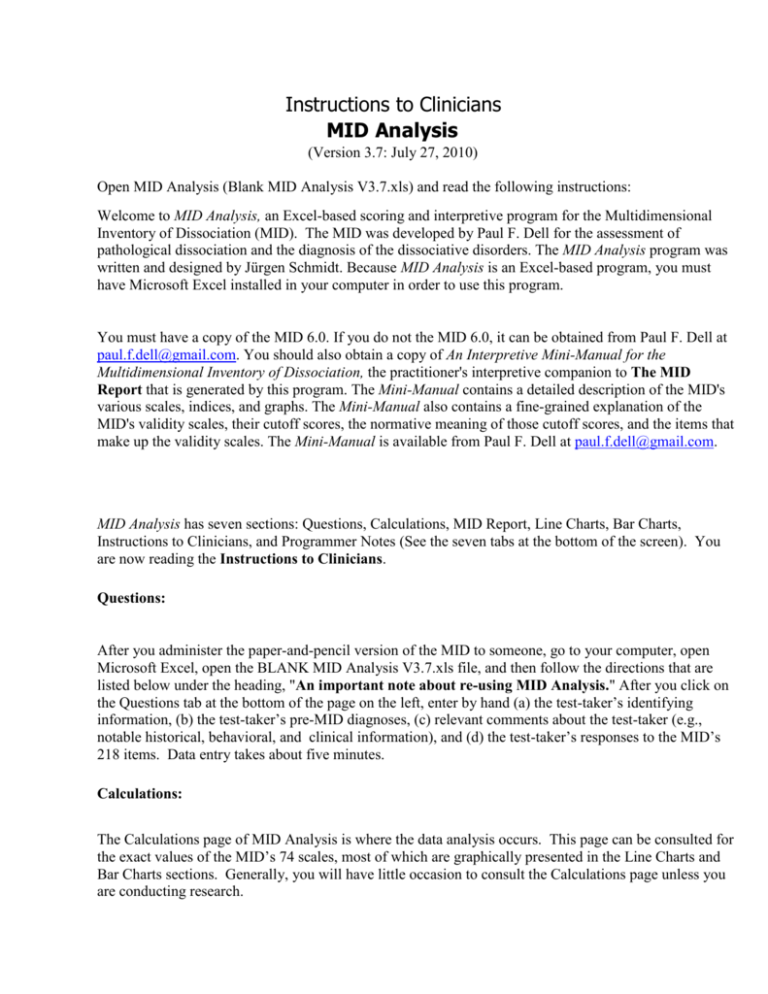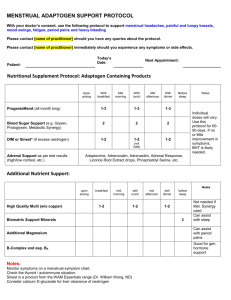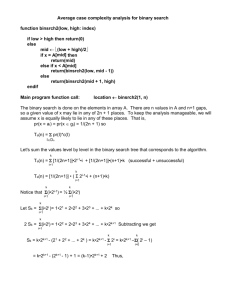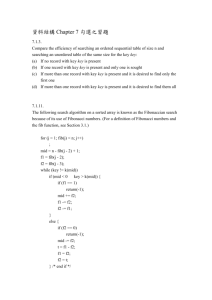Directions_for_scoring_the_MID
advertisement

Instructions to Clinicians MID Analysis (Version 3.7: July 27, 2010) Open MID Analysis (Blank MID Analysis V3.7.xls) and read the following instructions: Welcome to MID Analysis, an Excel-based scoring and interpretive program for the Multidimensional Inventory of Dissociation (MID). The MID was developed by Paul F. Dell for the assessment of pathological dissociation and the diagnosis of the dissociative disorders. The MID Analysis program was written and designed by Jürgen Schmidt. Because MID Analysis is an Excel-based program, you must have Microsoft Excel installed in your computer in order to use this program. You must have a copy of the MID 6.0. If you do not the MID 6.0, it can be obtained from Paul F. Dell at paul.f.dell@gmail.com. You should also obtain a copy of An Interpretive Mini-Manual for the Multidimensional Inventory of Dissociation, the practitioner's interpretive companion to The MID Report that is generated by this program. The Mini-Manual contains a detailed description of the MID's various scales, indices, and graphs. The Mini-Manual also contains a fine-grained explanation of the MID's validity scales, their cutoff scores, the normative meaning of those cutoff scores, and the items that make up the validity scales. The Mini-Manual is available from Paul F. Dell at paul.f.dell@gmail.com. MID Analysis has seven sections: Questions, Calculations, MID Report, Line Charts, Bar Charts, Instructions to Clinicians, and Programmer Notes (See the seven tabs at the bottom of the screen). You are now reading the Instructions to Clinicians. Questions: After you administer the paper-and-pencil version of the MID to someone, go to your computer, open Microsoft Excel, open the BLANK MID Analysis V3.7.xls file, and then follow the directions that are listed below under the heading, "An important note about re-using MID Analysis." After you click on the Questions tab at the bottom of the page on the left, enter by hand (a) the test-taker’s identifying information, (b) the test-taker’s pre-MID diagnoses, (c) relevant comments about the test-taker (e.g., notable historical, behavioral, and clinical information), and (d) the test-taker’s responses to the MID’s 218 items. Data entry takes about five minutes. Calculations: The Calculations page of MID Analysis is where the data analysis occurs. This page can be consulted for the exact values of the MID’s 74 scales, most of which are graphically presented in the Line Charts and Bar Charts sections. Generally, you will have little occasion to consult the Calculations page unless you are conducting research. The MID Report: The first page of The MID Report is a tabular score sheet that lists the test-taker's scores on 61 of the MID’s 74 scales. There is a wealth of information on this page. The more that you study these scores (especially in conjunction with reading the Mini-Manual), the more meaningful these scores will become. The Extended MID Report is appended to The MID Report. After entering a person's data into the Questions section of MID Analysis, you should immediately click on the MID Report tab and print the eight pages of The MID Report and The Extended MID Report. Interpreting the test-taker's MID protocol: In the lower right-hand corner of The MID Report, you will find suggested diagnoses and an assessment of the validity of the test-taker's responses to the MID. The diagnostic impressions that are generated by MID Analysis are based on clinically-sound diagnostic algorithms, but they are not an adequate substitute for a structured clinical evaluation of the person's posttraumatic and dissociative symptoms. The Extended MID Report provides an item-by-scale listing of the test-taker’s responses to the MID’s 218 items. You will quickly discover that The Extended MID Report gives you an excellent clinical 'feel' for the test-taker. The MID Extended Report is invaluable for understanding the precise meaning of an elevated scale. By consulting the person's responses to that scale in The Extended MID Report, you can discover exactly why the person has a high score on that scale. The Extended MID Report is also a natural guide to follow-up interviewing and first-hand clinical confirmation of a person’s dissociative experiences. For example, you might say, “On the MID, you indicated that you sometimes hear a voice that calls you names; you gave this item a rating of "3.". Could you tell me more about that?” Or, “On the MID, you indicated that you have had experiences of being told about something you did, but you had no memory of having done it; you gave this item a rating of "4.". Could you tell me more about that?” Or, “On the MID, you said that you sometimes feel like you have other parts inside. Could you tell me about that?” Line Charts: The Four MID Line Charts: MID Analysis illustrates the test-taker's MID scores on four graphs. The four graphs provide important diagnostic perspective on the test-taker's MID scores because each graph also A16shows the MID profiles of three diagnostic groups: (a) nondissociative psychotherapy patients, (b) DDNOS-1b patients, and (c) DID patients. The second thing that you should do after printing The MID Report is to click on either the Line Charts tab or the Bar Charts tab and print the charts. Some people prefer line charts; others prefer bar charts. I (PFD) prefer line charts. MID Analysis generates both line charts and bar charts. Both sets of charts contain exactly the same information. 1. MID Dissociation Scales Graph. This graph presents the test-taker’s mean scores for the 23 dissociative symptoms that are measured by the MID. 2. MID Diagnostic Graph. The MID Diagnostic Graph presents different information about the same 23 dissociative symptoms that were depicted by the previous graph. Of the four graphs, the MID Diagnostic Graph provides the clearest portrayal of the person's dissociative symptoms. Whereas the MID Dissociation Scales Graph shows mean scores, the MID Diagnostic Graph uses a different metric: clinical significance scores. A scale score of 100 or greater is clinically significant. If a scale has a score of 100 or higher, then the person has that symptom. On this graph, scale scores of less than 100 are generally clinically unimportant. The MID Diagnostic Graph also presents the person’s scores on the MID’s six validity scales. A validity scale score of 100 or greater is clinically significant. If a validity scale has a score of 100 or higher, then that person is definitely defensive (or attention-seeking, factitious, etc.). In some cases, validity scores of less than 100 are still clinically meaningful. Validity scales with scores that approach 100 should be taken into consideration when evaluating the test-taker. 3. MID Clinical Summary Graph. The MID Clinical Summary Graph presents information from 27 MID scales. If you compare the scores on the MID Clinical Summary Graph with scores elsewhere in The MID Report (or on other MID graphs), you will discover that the scores often differ. They differ because most of the scores on the MID Clinical Summary Graph are neither mean scores, nor clinical significance scores. While a few scales do, indeed, present the person’s mean score, most scales on the MID Clinical Summary Graph present the percentage of items that the person ‘passed’ on that scale (For further information about this, see the Mini-Manual). The MID Clinical Summary Graph organizes 27 MID scales into five clusters: (1) Dissociation scales, (2) Parts and Alters scales, (3) Validity scales, (4) Characterological scales, and (5) Functionality/Impairment scales (Note: Higher scores = greater impairment of functioning). Careful study of a person’s scores on the MID Clinical Summary Graph are often especially revealing of characterological aspects of that person’s clinical ‘picture.’ Nowhere in the data reported by MID Analysis are problematic Axis II traits so readily visible as they are in the MID Clinical Summary Graph. 4. MID Factor Scales Graph. The MID Factor Scales are based on a large (N = 1,359) factor analysis of the MID's 168 dissociation items. That factor analysis identified 12 first-order factors. Hierarchical factor analysis of the 12 first-order factors extracted a single second-order factor (i.e., dissociation). The MID Factor Scales Graph reports mean scores for each of the 12 first-order factors. The PTSD profile on this graph is for PTSD patients who are not dissociative. Bar Charts: As noted above, some people prefer line charts; others prefer bar charts. The bar charts contain exactly the same information as the line charts. Research with the MID: MID Analysis cannot score more than one patient's MID protocol at a time. If you want to conduct research with the MID, I recommend that you contact me. The macros in my statistics program can score hundreds of MID protocols at the same time. I am willing to score your MID data if you first enter the data into either an Excel or SPSS spreadsheet. I also will probably ask you about the possibility of data sharing (where you retain full ownership of the data). I am especially interested in researchers who plan to use the SCID-D or the DDIS, but I am willing to do batch scoring for any researcher that is using the MID. An important note about re-using MID Analysis: There are two ways to re-use the MID Analysis program. The first way to re-use MID Analysis (i.e., deleting the previous scores from the Questions page) destroys the data and destroys the report from the preceding test-taker. I recommend against doing this. In order to save your data and report for each person, you must do two things: (1) Open Microsoft Excel and then open the file entitled, Blank MID Analysis V3.7.xls; (2) IMMEDIATELY click on File Save As and give the file (i.e., Blank MID Analysis V3.7.xls) a new name (e.g., Patient name MID Analysis V3.7xls). By doing this, you have left the file, Blank MID Analysis V3.7.xls, blank and you have created an entirely new MID Analysis program into which you can now enter the data on your new patient. When you follow this procedure, you will create a new MID Analysis program for each new patient and you will never enter data into Blank MID Analysis V3.7.xls. Obtaining consultation to help interpret a patient's MID protocol: During previous years (while the MID and MID Analysis were being developed), I scored MID protocols that were faxed to me and sent back brief interpretive reports gratis. I did this to allow practitioners to use the MID and in order to expand the MID research database. To date, I have written over 900 MID reports. Developing the MID and writing hundreds of MID reports has taught me a great deal about the MID profiles of patients with psychosis, depersonalization disorder, PTSD, DDNOS-1b, DID, borderline personality disorder, factitious disorder, and so on. Because I want to acquire more research data, I will continue to analyze MID protocols for free if your patient is willing to take two other tests and grant permission for anonymous inclusion of his/her clinical data in the MID research database. How to reference the MID if you are writing an article: The correct citation for the MID is: Dell, P. F. (2006). The Multidimensional Inventory of Dissociation (MID): A comprehensive measure of pathological dissociation. Journal of Trauma & Dissociation, 7(2), 77-106. If you want to obtain a thorough understanding of the concept of dissociation upon which the MID is based, you should read: Dell, P.F. (2006). A new model of dissociative identity disorder. Psychiatric Clinics of North America, 29(1), 1-26. This article won the Pierre Janet Award, for the best publication on dissociation in 2006, from the International Society for the Study of Trauma and Dissociation. How to Export The MID Report to a Word Processing Program Exporting The MID Report, plus The Extended MID Report, plus the four graphs to a word processing program (for a report or to send portions of The MID Report by email) is a bit of a pain, but it is quite do-able. The ‘easiest’ way to do this is as follows. 1. Open your word processing program to a blank page 2. Then open The MID Report 2a. Highlight only the tabular scoresheet. [Note: To highlight, (1) place the cursor in the upper left-hand corner of what you want to highlight, (2) hold down the left mouse button, (3) move the cursor to the upper right-hand corner of what you want to highlight, and (4) then move the cursor down the right-hand side of what you want to copy until you reach the bottom of what you want to copy.] 2b. Then, release the left-hand mouse button 2c. Click on Edit in the upper left-hand corner and then click on Copy 3. Open your word processing program to the blank page 3a. Click on Edit 3b. Click on Paste Special 3c. Click on Picture and then Click OK 3d. Push the Page Down button on your keyboard 3e. Click on Insert at the Upper left of the toolbar 3f. Click on Break 3g. Select Page Break and click OK 4. Follow the same procedure for each page of The Extended Report and for each graph until you have copied the entire report to your word processing document. Then you can save the word processing document and send it as an email attachment. As I said, sending The MID Report to someone by email is a pain, but it is very do-able.






